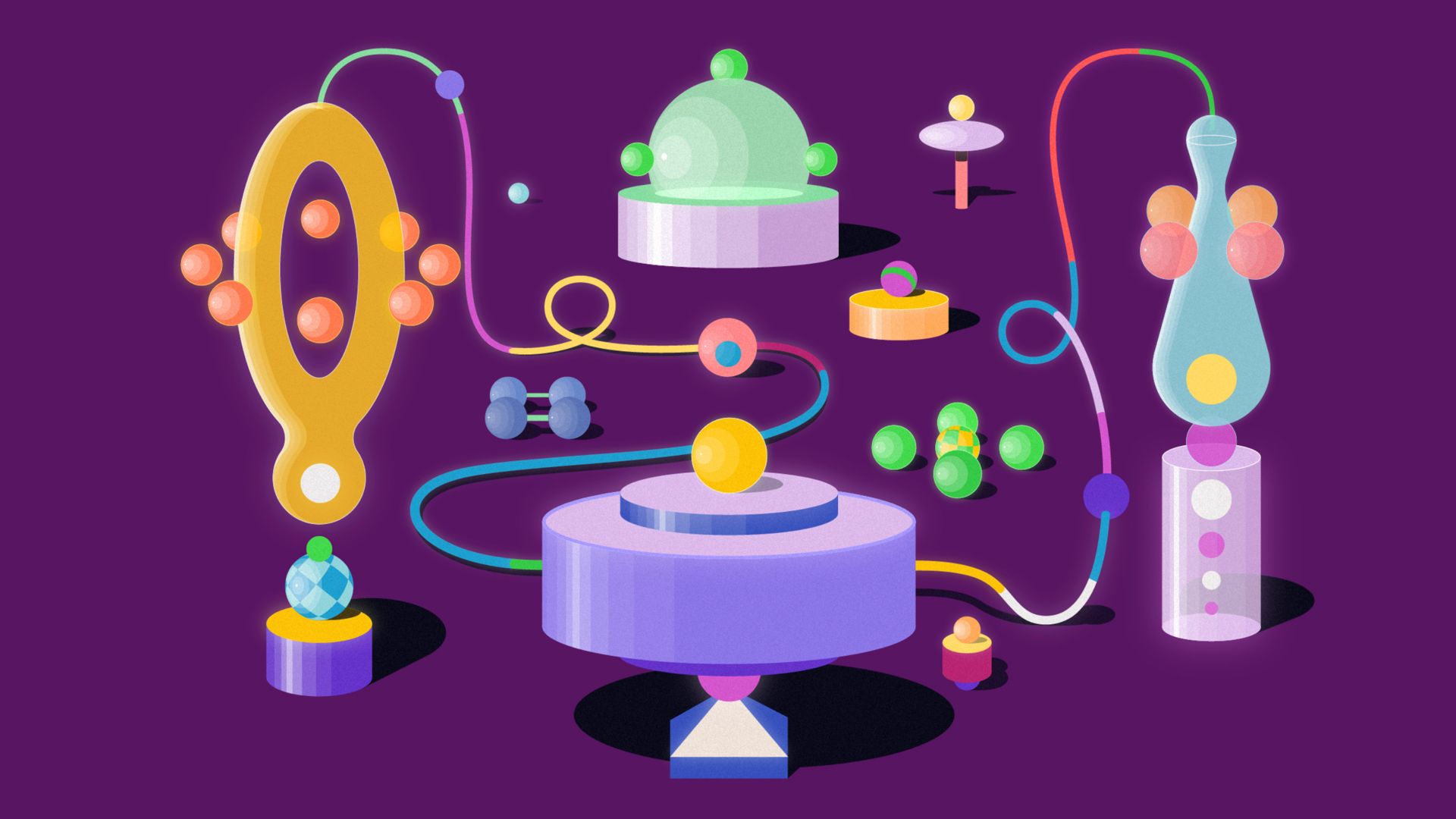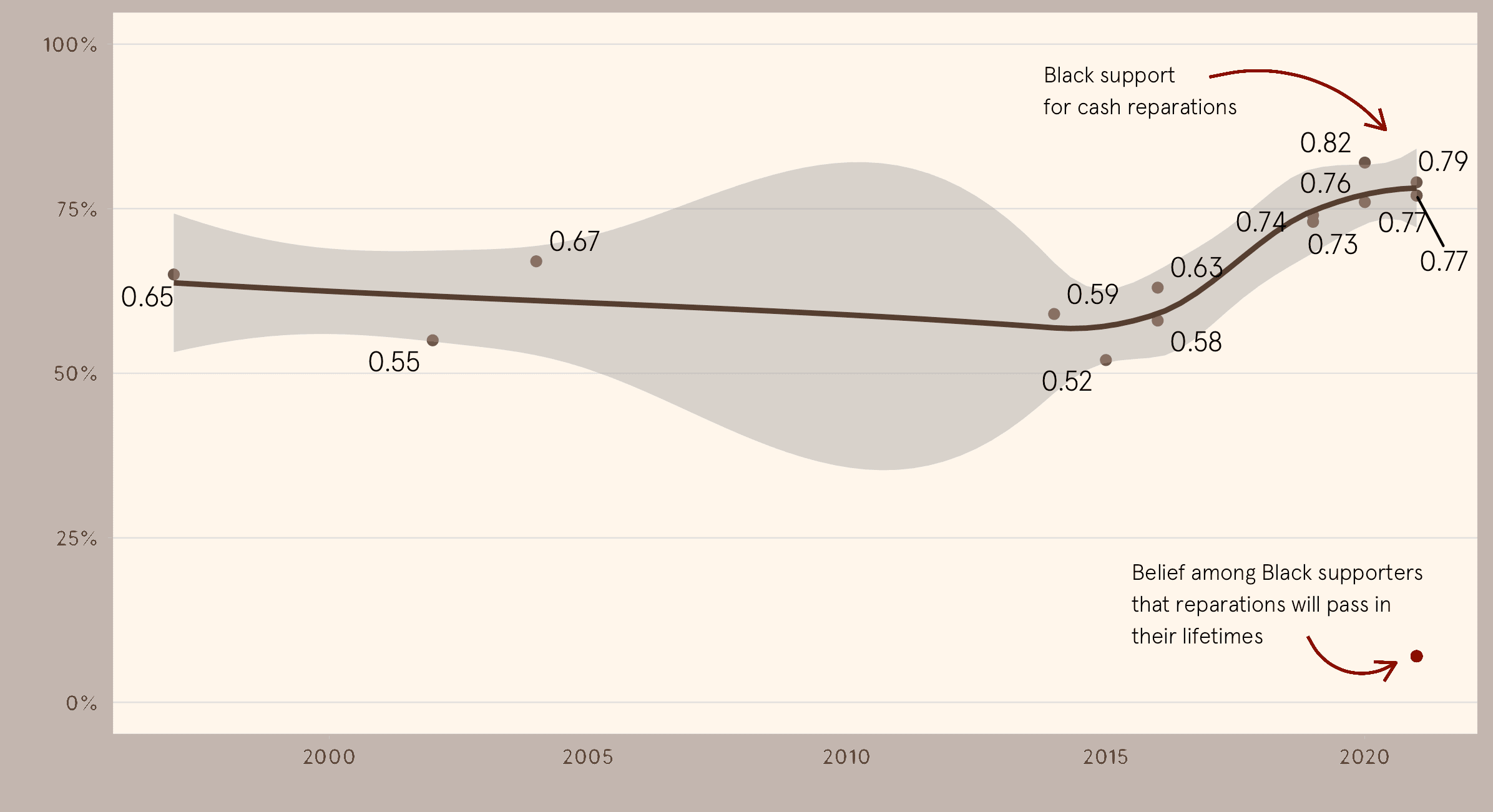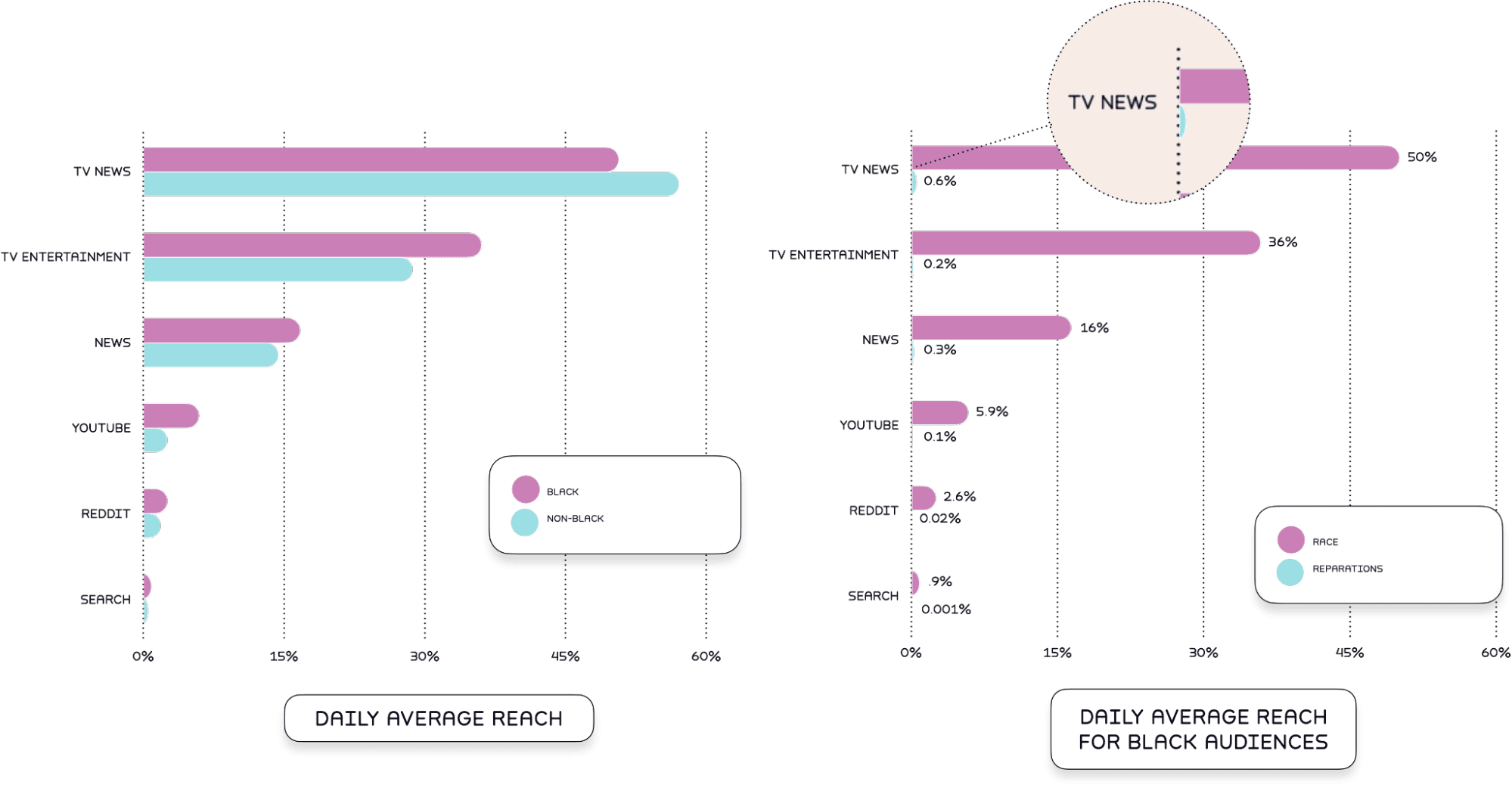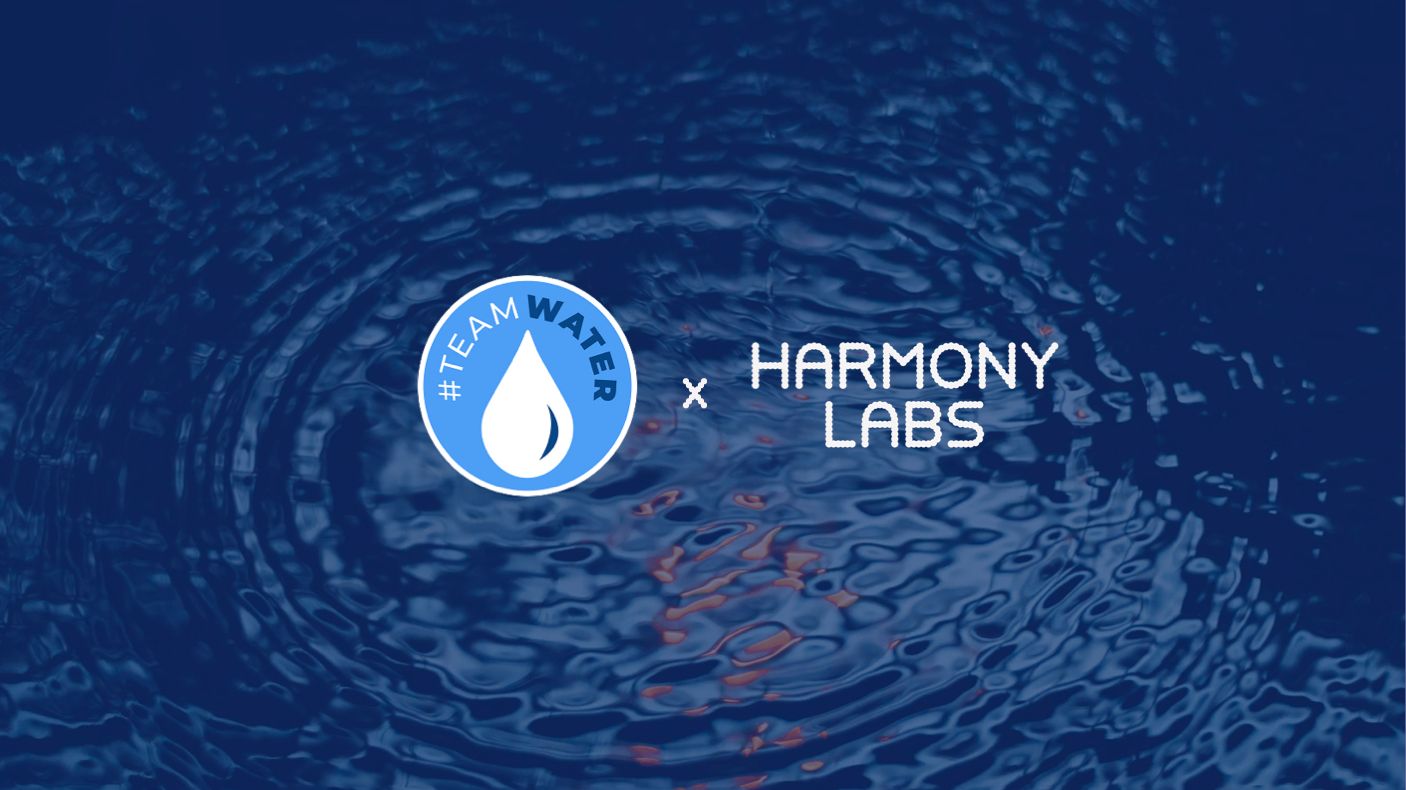Four Principles For Building Power in Media


2023-09-13
Support for reparations among Black people in the United States has grown sharply in recent years and is now consistently over 70%. However, only 7% of Black people that support reparations believe they are extremely or very likely to happen in their lifetime, creating what we call a “hope gap”: the gap between the belief that reparations should be paid versus believing that they will be paid.

There are a number of reasons why this gap exists, most notably the repeated broken promises by the federal government to solve issues of anti-Blackness and racial inequality.
The Reparations Narrative Lab, Liberation Ventures’ first narrative change program, was interested in better understanding and reaching Black audiences across the country, to close this “hope gap,” creating a vision for a shared narrative across the movement working to advance reparations in the U.S.
Knowing that the Black community is not a monolith, we partnered with Harmony Labs in an effort to go beyond typical demographic audience definitions to make further progress in persuading the public to support reparations. To support these efforts, Harmony Labs explored audiences’ current media consumption about race and reparations to provide the Lab building blocks for the construction of our Narrative House.
The Black community, like all racial communities, holds an array of cultural nuances across geography, age, sexual orientation, and numerous other personal identities. In addition to the connections that exist across identity within the Black community, we sought to understand where Black folks fall within the different cultural values that exist within U.S. society. Values-based, culture-forward audience segmentation helps us understand what motivates our audiences and how they encounter an issue, narrative, or type of content in their media and cultural intake, providing important advantages for narrative and cultural strategy.
Harmony Labs found in their research that stories that discuss race have a high reach overall across the general U.S. population, particularly in television and in online news, and reach is highest with Black audiences everywhere (except TV news). However, the research also indicated that reparations stories have very low reach, as demonstrated in the Daily Average Reach charts below.

Audiences are simply not consuming very much content about reparations, creating a content vacuum. In other words, a “blank space” in media within which even basic messaging about reparations may play an influential role in shaping audiences’ perceptions about them, and new media about reparations can be created without running up against an already-dense media space.
Because reparations reach is so low, there were relatively few pieces of media that panelists in Harmony Labs’ data actually consumed (see methods section below for technical details on these panels). Rather than use big data statistical methods, researchers were able to consume all of the reparations content that panelists saw in order to develop findings about the nature of reparations media that audiences see and the narratives about reparations that they hold.
So while few people are currently consuming content about reparations, exploring the content about reparations that people do consume is still instructive. Existing reparations narratives typically break down into: defining it (compensation, apologies) or justifying it, à la Ta-Nehisi Coates’ “The Case for Reparations.”
Anti-reparations narratives uses consistent messaging, often carried by a few spokespeople that reach mostly non-Black audiences, focusing on outcomes versus actual harms—and rationalizing and explaining away racial disparities.
On a general level, some voices on digital platforms are ubiquitous and have relatively high reach across audiences and demographics (for example, CNN’s channel on YouTube). Other voices, however, reach certain audiences more distinctively—that is, they have a significantly higher reach in Black vs. non-Black audiences. These higher reach Black voices on Twitter are almost all pro-reparations—and even those who are less vocal about reparations have other users who mention them in posts about reparations. An example of a “distinct voice” is Kandi. Getting clarity on influential voices within the Black community and on the topic of reparations will be important as more organizations craft specific strategies seeking to reach different audiences.
Notably absent from current narratives within media: what reparations will feel like, or what a post-reparations future will look like. Building these elements into storytelling may help to close the “hope gap” identified above. One notable exception is this video from The Cut, in which people talk about what reparations could look like and the impact they will have. Telling better future stories of what reparations will feel or look like means effectively portraying this imagined future resulting from the desired change.
The Reparations Narrative Lab sought to portray our vision of this future through our Narrative House schema, and more specifically, our Narrative North Star, which we define as the articulation of the world we are building. The Reparations Narrative Lab collaborated with a cohort of storytellers to test the Narrative House and use this research to test new stories that describe a clear vision for a post-reparations future.
Over the next year, we hope that the Narrative House can be used as a tool for organizations throughout the racial justice movement to organize their internal thoughts, narratives, and strategies in a way that aligns with the broader movement’s narrative. Doing this will help build power around the array of narratives that make up the full story of reparations for Black people in the United States. As part of this, we will launch a Reparations Cultural Fellowship where artists from different disciplines will focus on a specific narrative and bring it to life through their art form over the course of a year.
Harmony Labs’ values-based audience segmenation offered the Narrative Lab a valuable tool for understanding entry points for narrative intervention specific to groups with distinct attitudes and cultural affinities that participate in distinct media cultures, engaging with and consuming the same content.
To measure the audience values that form the foundation of the segmentation, we use surveys that explore attitudes on race, gender, place, and class, along with core values. Using these results, we create four audiences and a suite of predictive models that help us assign audience scores to the nationally representative, opt-in media consumption panels based on demography, geography, and lifestyle features (e.g., age, gender, race, zip code). Media consumption panels give us visibility into the minute-by-minute media behaviors—of over 300,000 people in the U.S., who opted in and are compensated for their participation—across desktop, mobile, tablet, and TV. This allowed us to enrich our audience profiles with the media artifacts—videos, news articles, TV shows, Tweets, Pinterest pins—that actual audience members actually engaged with.
By segmenting a communications approach to intervention on a per-audience basis, the Narrative Lab and other storytellers in the racial justice movement can meet each audience where they’re already at, and build segmented strategies to bring those audiences closer to their vision.
| People Power (Community Centric) | If You Say So (Autonomy Centric) | Tough Cookies (Order Centric) | |
|---|---|---|---|
| Opportunity | Build a sense that people can come together to make reparations a reality, as they have in the past. | Represent reparations as removing barriers to individual success. Reparations are not at odds with autonomy. | Show that governments hold themselves accountable to right wrongs and change when they make mistakes and that the new order that reparations will create will make the entire country better off. |
| Tone | Densely informational and historical | Pop culture relevant, with messaging from entrepreneurs and celebrities | Straightforward, fact and process oriented |
About Harmony Labs
Harmony Labs is a media research lab, using science, data, and creativity to research and reshape our relationship with media. For more than a decade, their work has helped storytellers and strategists, decision makers and dreamers, harness the immense power of media to shape a positive, pluralistic future.
About Liberation Ventures
Liberation Ventures accelerates the Black-led movement for racial repair. They are building a multiracial democracy that works for all of us — by making racial repair a reality in the United States. They are realizing a dream in our name, where reparations for Black people unlocks true belonging for us all.



